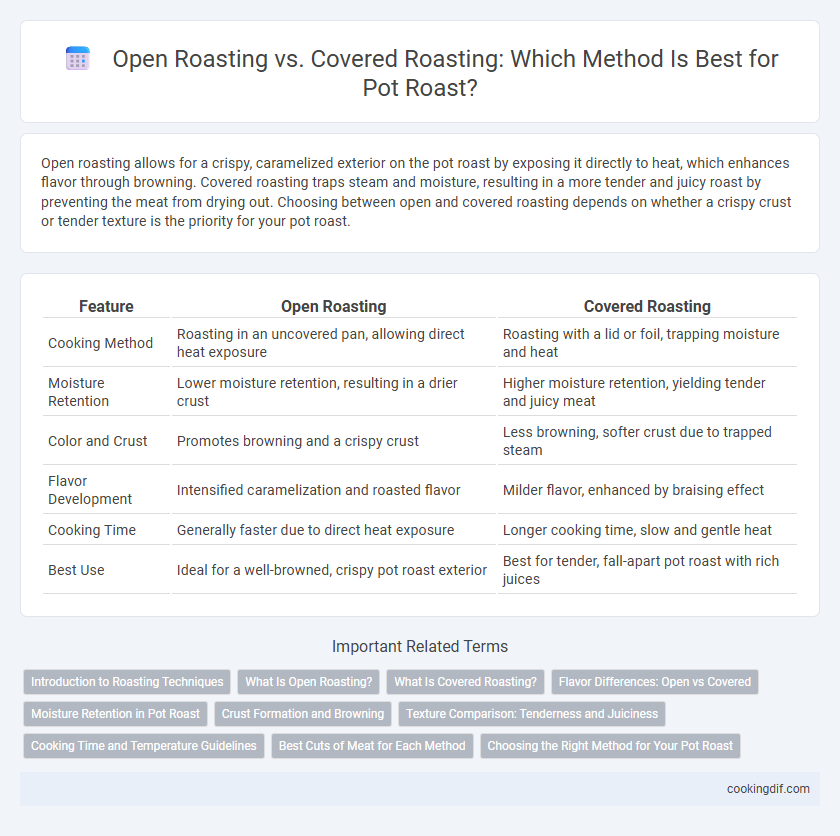Open roasting allows for a crispy, caramelized exterior on the pot roast by exposing it directly to heat, which enhances flavor through browning. Covered roasting traps steam and moisture, resulting in a more tender and juicy roast by preventing the meat from drying out. Choosing between open and covered roasting depends on whether a crispy crust or tender texture is the priority for your pot roast.
Table of Comparison
| Feature | Open Roasting | Covered Roasting |
|---|---|---|
| Cooking Method | Roasting in an uncovered pan, allowing direct heat exposure | Roasting with a lid or foil, trapping moisture and heat |
| Moisture Retention | Lower moisture retention, resulting in a drier crust | Higher moisture retention, yielding tender and juicy meat |
| Color and Crust | Promotes browning and a crispy crust | Less browning, softer crust due to trapped steam |
| Flavor Development | Intensified caramelization and roasted flavor | Milder flavor, enhanced by braising effect |
| Cooking Time | Generally faster due to direct heat exposure | Longer cooking time, slow and gentle heat |
| Best Use | Ideal for a well-browned, crispy pot roast exterior | Best for tender, fall-apart pot roast with rich juices |
Introduction to Roasting Techniques
Open roasting exposes the pot roast directly to dry heat, promoting a crispy, caramelized exterior while maintaining a tender interior. Covered roasting traps moisture and steam, resulting in a juicier, more evenly cooked pot roast with enhanced flavor infusion. Understanding the differences between open and covered roasting helps optimize texture and taste based on preferred outcomes.
What Is Open Roasting?
Open roasting is a cooking method where the pot roast is exposed directly to the oven's dry heat without a cover, allowing the exterior to caramelize and develop a rich, browned crust. This technique promotes Maillard reactions, enhancing flavor complexity and creating a crisp surface texture. Open roasting requires careful temperature control to prevent drying out while achieving a tender interior and deeply flavored crust.
What Is Covered Roasting?
Covered roasting involves cooking the pot roast in a tightly sealed environment, such as a Dutch oven or roasting pan with a lid, which traps moisture and heat around the meat. This method enhances tenderness by allowing the roast to braise in its own juices, preventing drying out during the slow cooking process. Covered roasting is ideal for tougher cuts of meat, as the moist heat breaks down collagen, resulting in a succulent, flavorful pot roast.
Flavor Differences: Open vs Covered
Open roasting pot roast allows Maillard reactions to intensify, producing a deep, caramelized crust and robust, smoky flavors that enhance the meat's savory profile. Covered roasting traps moisture and steam, resulting in a tender, juicy roast with more subtle, concentrated beef flavors and less surface browning. Choosing between open or covered roasting impacts the balance between bold, textured exterior flavors and soft, moist interior taste.
Moisture Retention in Pot Roast
Open roasting pot roast exposes meat to direct heat and air, often resulting in greater moisture loss and drier texture. Covered roasting traps steam and heat inside, promoting moisture retention and a juicier, more tender pot roast. Using a tight-fitting lid or foil cover helps maintain optimal humidity levels, enhancing the meat's succulence during cooking.
Crust Formation and Browning
Open roasting promotes superior crust formation and intense browning on pot roast due to direct exposure to dry heat, which facilitates Maillard reactions on the meat's surface. Covered roasting traps steam, resulting in a moister environment that softens the crust and limits browning by hindering surface dehydration. For optimal caramelization and a richly textured crust, open roasting is the preferred method.
Texture Comparison: Tenderness and Juiciness
Open roasting promotes a caramelized crust that enhances flavor but can lead to drier edges due to direct heat exposure, affecting juiciness. Covered roasting traps moisture, resulting in uniformly tender meat that retains juiciness by preventing evaporation. The choice between open and covered roasting directly influences the pot roast's texture, balancing crispness against succulence.
Cooking Time and Temperature Guidelines
Open roasting pot roast requires higher temperatures, typically around 350degF, and shorter cooking times of 1.5 to 2 hours, allowing for a browned, crispy exterior. Covered roasting uses lower temperatures, about 275degF to 300degF, and longer cooking times between 3 to 4 hours, promoting tender, juicy meat by trapping steam and moisture. Adjusting temperature and time based on whether the roast is open or covered ensures optimal texture and flavor development.
Best Cuts of Meat for Each Method
Open roasting is ideal for tougher, marbled cuts like chuck roast or brisket, as the direct heat and dry environment enhance caramelization and flavor development. Covered roasting suits leaner cuts such as round roast or rump roast, allowing slow cooking in moist heat to break down connective tissue and maintain tenderness. Selecting the right method based on the cut ensures optimal texture and rich, developed flavors in the pot roast.
Choosing the Right Method for Your Pot Roast
Open roasting enhances caramelization and creates a crispy exterior on pot roast through direct heat exposure, ideal for tender cuts with shorter cooking times. Covered roasting traps moisture, resulting in a juicier, more tender pot roast by slow-cooking tougher cuts in their own juices. Selecting the right method depends on the cut of meat and desired texture: choose open roasting for a browned crust and quicker cooking, or covered roasting for fall-apart tenderness and richer flavors.
Open Roasting vs Covered Roasting for pot roast Infographic

 cookingdif.com
cookingdif.com